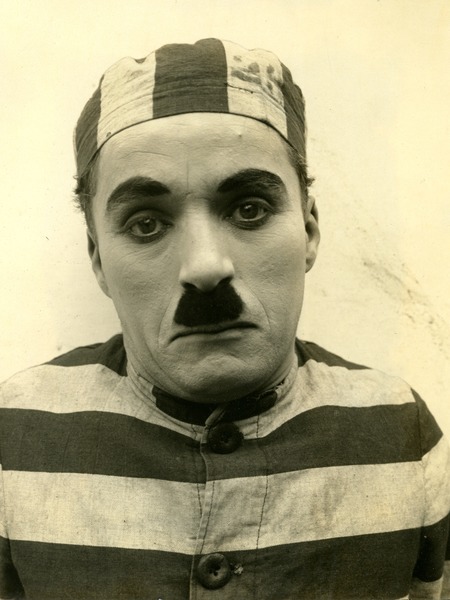
- Year :
- 1917
- Cast :
- Charles Chaplin, Edna Purviance, Henry Bergman, Marta Golden, Eric Campbell, Albert Austin, Toraichi Kono, John Rand, Frank J. Coleman, Loyal Underwood, May White, Janet Miller Sully, Monta Bell
- Production :
- Mutual
- Description :
- Chaplin and his brother Sydney went to San Francisco for a vacation after completing The Immigrant. Chaplin was growing tired from the hectic pace of the series; four months passed before the last film, The Adventurer, was released—the longest interval between films for Chaplin in his entire career up to that time. The most popular of the Mutuals, The Adventurer begins and ends with a chase. It is the fastest-paced film of the series, and although it has more slapstick than Easy Street and The Immigrant, it is redeemed by its construction, characterization, and Chaplin’s balletic grace. A famous moment in the film has Charlie spilling ice cream down the front of his over-sized trousers. Chaplin wrote a detailed analysis of the scene in his article, “What People Laugh At”: *"All my pictures are built around the idea of getting me into trouble and so giving me the chance to be desperately serious in my attempt to appear as a normal little gentleman. That is why, no matter how desperate the predicament is, I am always very much in earnest about clutching my cane, straightening my derby hat and fixing my tie, even though I have just landed on my head.* *I am so sure of this point that I not only try to get myself into embarrassing situations, but I also incriminate the other characters in the picture. When I do this, I always aim for economy of means. By this I mean that when one incident can get two big, separate laughs, it is much better than two individual incidents. In The Adventurer I accomplish this by first placing myself on a balcony, eating ice cream with a girl. On the floor directly underneath the balcony, I put a stout, dignified, well-dressed woman at a table. Then, while eating the ice cream, I let a piece drop off my spoon, slip through my baggy trousers, and drop from the balcony onto this woman’s neck.* *The first laugh came at my embarrassment over my own predicament. The second, and the much greater one, came when the ice cream landed on the woman’s neck and she shrieked and started to dance around. Only one incident had been used, but it had got two people into trouble and had also got two big laughs.* *Simple as this trick seems, there were two real points of human nature involved in it. One was the delight the average person takes in seeing wealth and luxury in trouble. The other was the tendency of the human being to experience within himself the emotions he sees on the stage or screen.* *One of the things most quickly learned in theatrical work is that people as a whole get satisfaction from seeing the rich get the worst of things. The reason for this, of course, lies in the fact that nine tenths of the people in the world are poor, and secretly resent the wealth of the other tenth.* *If I had dropped the ice cream, for example, on a scrubwoman’s neck, instead of getting laughs sympathy would have been aroused for the woman. Also, because a scrubwoman has no dignity to lose, the point would not have been funny. Dropping ice cream down a rich woman’s neck, however, is, in the minds of the audience, just giving the rich what they deserve.* *By saying that human beings experience the same emotions as the people in the incidents they witness, I mean that—taking ice cream as an example—when the rich woman shivered the audience shivered with her. A thing that puts a person in an embarrassing predicament must always be perfectly familiar to an audience, or else the people will miss the point entirely. Knowing that the ice cream is cold, the audience shivers. If something else was used that the audience did not recognize at once, it would not be able to appreciate the point as well. On this same fact was based the throwing of custard pies in the early pictures. Everyone knew that custard pie is squashy and so was able to appreciate how the actor felt when one landed on him."* Other highlights from the film include Charlie donning a lampshade and freezing in position as the guards run past him and a chase in which he dodges a prison guard and the rival by using sliding double doors which become, in turn, a head-stock, a moveable wall, and an escape route. It is ironic that in his last film of the demanding Mutual series Charlie escapes from prison. In contrast with Essanay, Chaplin’s relationship with the Mutual Film Corporation ended amicably. Indeed, Mutual offered him a million dollars for eight more films, but Chaplin sought even greater independence. Chaplin later wrote, “Fulfilling the Mutual contract, I suppose, was the happiest period of my career. I was light and unencumbered, twenty-seven years old, with fabulous prospects and a friendly, glamorous world before me.” Text by Jeffrey Vance, adapted from his book Chaplin: Genius of the Cinema (New York, 2003) © 2009 Roy Export SAS
- DVD & Blu-ray :